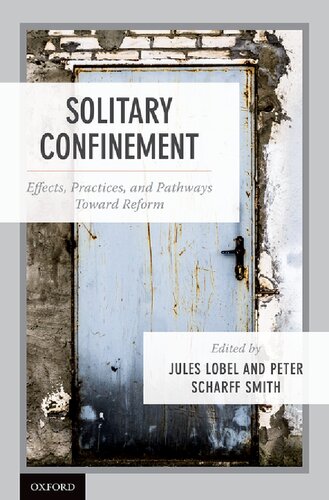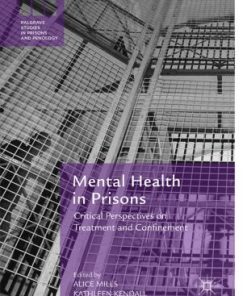Solitary Confinement: Effects, Practices, and Pathways Towards Reform 1st Edition Jules Lobel
$50.00 Original price was: $50.00.$25.00Current price is: $25.00.
Solitary Confinement: Effects, Practices, and Pathways Towards Reform 1st Edition – Ebook Instant Download/Delivery ISBN(s): 9780190947958, 0190947950

Product details:
- ISBN-10: 0190947950
- ISBN-13: 9780190947958
- Author: Jules Lobel, Peter Scharff Smith
The use of solitary confinement in prisons became common with the rise of the modern penitentiary during the first half of the nineteenth century and his since remained a feature of many prison systems all over the world. Solitary confinement is used for a panoply of different reasons although research tells us that these practices have widespread negative health effects. Besides the death penalty it is arguably the most punitive and dangerous intervention available to state authorities in democratic nations. Nevertheless, in the United States there is currently an estimated 80-100,000 prisoners in small cells for more than 22 hours per day with little or no social contact and no physical contact visits with family or friends. Even in Scandinavia, thousands of prisoners are placed in solitary confinement every year and with an alarming frequency. These facts have spawned international interest in this topic and a growing international reform movement, which includes researchers, litigators and human rights defenders as well as prison staff and prisoners. This book is the first to take a broad international comparative approach and to apply an interdisciplinary lens to this subject. In this volume neuroscientists, high level prison officials, social and political scientists, medical doctors, lawyers and former prisoners and their families from different countries will address the effects and practices of prolonged solitary confinement and the movement for its reform and abolition.
Table contents:
1. Solitary Confinement—From Extreme Isolation to Prison Reform
I. Two Centuries of Solitary Confinement
2. Solitary Confinement—Effects and Practices from the Nineteenth Century until Today
3. Global Perspectives on Solitary Confinement—Practices and Reforms Worldwide
4. Solitary Confinement across Borders
5. The Rise of Supermax Imprisonment in the United States
6. Not Isolating Isolation
7. Torture, Solitary Confinement, and International Law
II. Mind, Body, and Soul—The Harms and Experience of Solitary Confinement
8. Solitary Confinement, Loneliness, and Psychological Harm
9. First Do No Harm: Applying the Harms-to-Benefits Patient Safety Framework to Solitary Confinement
10. Mythbusting Solitary Confinement in Jail
11. Social Isolation, Loneliness, and Health
12. The Brain in Isolation: A Neuroscientist’s Perspective on Solitary Confinement
13. Use of Animals to Study the Neurobiological Effects of Isolation: Historical and Current Perspectives
14. Sharing Experiences of Solitary Confinement—Prisoners and Staff
III. Prison reform, prison litigation, and human rights
15. The Management of High-Security Prisoners: Alternatives to Solitary Confinement
16. Resisting Supermax: Rediscovering a Humane Approach to the Management of High-Risk Prisoners
17. Prisoners’ Association as an Alternative to Solitary Confinement—Lessons Learned from a Norwegian High-Security Prison
18. Colorado Ends Prolonged, Indeterminate Solitary Confinement
19. Reflections on North Dakota’s Sustained Solitary Confinement Reform
20. Solitary Confinement in Canada
21. “Loneliness Is a Destroyer of Humanity”
22. Litigation to End Indeterminate Solitary Confinement in California: The Role of Interdisciplinary and Comparative Experts
People also search:
Solitary Confinement: Effects, Practices, and Pathways Towards Reform
solitary confinement cell
what does solitary confinement do to a person
solitary confinement and mental health
alternatives to solitary confinement
You may also like…
Computers - Applications & Software
Poetry - American Poetry
Metaphors of Confinement: The Prison in Fact, Fiction, and Fantasy
Politics & Philosophy - Anthropology
Languages - English as a Foreign Language & Reference
Relationships & Lifestyle - Psychological Self-Help
Mental Health in Prisons: Critical Perspectives on Treatment and Confinement 1st Edition
Politics & Philosophy - Anthropology
Education Studies & Teaching - School Education & Teaching
English as a Lingua Franca in Japan: Towards Multilingual Practices 1st Edition
Biology and other natural sciences - Molecular
Disease Pathways: An Atlas of Human Disease Signaling Pathways Anastasia Nesterova Et Al.












